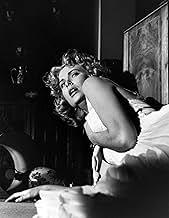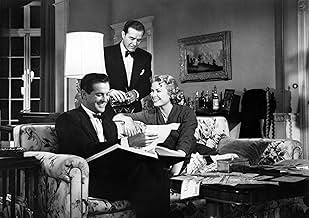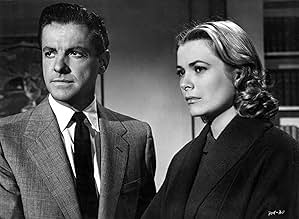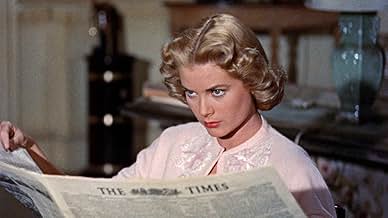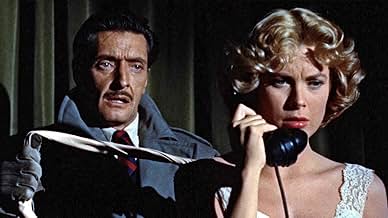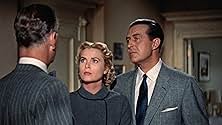Ein ehemaliger Tennisprofi schmiedet ein Komplott, seine Frau umzubringen. Als es misslingt, improvisiert er schnell einen Plan B.Ein ehemaliger Tennisprofi schmiedet ein Komplott, seine Frau umzubringen. Als es misslingt, improvisiert er schnell einen Plan B.Ein ehemaliger Tennisprofi schmiedet ein Komplott, seine Frau umzubringen. Als es misslingt, improvisiert er schnell einen Plan B.
- Nominiert für 1 BAFTA Award
- 5 Gewinne & 3 Nominierungen insgesamt
- Banquet Member
- (Nicht genannt)
- Detective
- (Nicht genannt)
- Bobby Outside Flat
- (Nicht genannt)
- Police Photographer
- (Nicht genannt)
- Detective
- (Nicht genannt)
- Woman Departing Ship
- (Nicht genannt)
- Banquet Member
- (Nicht genannt)
- Banquet Member
- (Nicht genannt)
Zusammenfassung
Empfohlene Bewertungen
Ray Milland (Tony Wendice) is a surprisingly sympathetic villain (which is perhaps not surprising from the actor with talent, charm, and charisma that equal and remind a lot of both Cary Grant and Jimmy Stewart) who knows about his wife cheating and decides to teach her a lesson by plotting a very clever murder which will make him a sole heir to her money (she is a wealthy one in the family). His plan is perfect and almost works but Margot managed to not only escape the murderer but to turn the table on him while stunned Wendice is on the phone and listens how his well thought of plan collapses. Wendice is very resourceful and he proved to be a master of improvisation because it took him a few minutes in a cab to switch to a plan B that turned a terrified victim Margot into a cold-blooded murderess. Now it is up to seasoned and shrewd inspector Hubbard (John Williams) to find the crucial piece of evidence and to solve the case.
As always with Hitchcock, his directing is impeccable, the camera rarely leaves Wendice's apartment but the film is never claustrophobic which is the case for many plays' adaptation. It breathes and moves freely and we almost forget that we are in the same room for close to two hours. I would not call "Dial M for Murder" my favorite Hitchcock's film but it is enjoyable, clever, and witty thriller with the interesting twists, outstanding performances, and more than one truly memorable scenes.
Dial M for Murder succeeds on many levels, and it is largely thanks to some superb dialogue, written from a tricksy-yet-capable script that never gets too deep. The cast are a treat. Ray Milland is an absolute gem, extremely sly and dispassionate, yet a character so full of self-assurance that one almost sides with him. Grace Kelly completes her great year (she gave an Oscar-winning performance in The Country Girl and also starred in Rear Window) by emanating the poised, beautiful being, that is vulnerable, yet oddly unassailable. And it's weird in that even though she's cheating on her husband, you care for her a lot more than him (although that could do with the fact that he's trying to kill her...) And John Williams, as the police detective, is quite wonderful.
Alfred Hitchcock manipulates and enthrals his audience here like the master that he is. Each scene has a sense of direction, great pacing, and is staged realistically. Stunning full colour photography and a haunting, atmospheric score from Dimitri Tiomkin complete this great package. The ending, when it comes, feels a little too nice to be truly realistic, but that is my only major quibble with an otherwise highly entertaining, thrilling movie.
The movie is the story of Tony Wendice (Ray Milland), a former tennis player married to the beautiful and wealthy Margot (Grace Kelly) and living in an nice apartment in London. Life is good for Tony, until he discovers that his wife is cheating on him with an old flame of her, famous crime novel writer Mark Halliday (Robert Cummings). After that discovery, Tony spends a whole years plotting the perfect way to murder his wife in order to inherit her money, carefully planning every detail of the crime. When Mark visits London again, Tony finds the perfect chance to set his plan in motion, and as planned, he recruits Charles Swann (Anthony Dawson) to kill his wife. However, bad luck and a sudden change of events will test Tony's plan's infallibility as, just as Mark points out, human action can originate flaws even in the most perfectly devised plan.
Like most Hitchcock's films, "Dial M for Murder" was an adaptation of another art-form, this time a popular play by Frederick Knott. As Knott was also the writer of the screenplay, the movie remains extremely faithful to the play, although of course, not without its differences. Knott's script is wonderfully constructed, as like in the play, the dialog is witty and simply captivating, with many twists and turns that spiced up the complex plot and keep it from being boring or tiresome. An interesting feature of the movie is that oddly, there are no black and white morality in the characters, and it's easy not only to sympathize with Margot (despite she being cheating on her husband) but also to sympathize with Tony (despite he wanting to kill his wife), as the characters are wonderfully developed with very detailed personalities.
It seems that Hitchcock's knows that the dialog is the highlight of the play, as he deliberately focuses on his actors and uses an elegant camera-work to frame the whole movie inside the apartment. The movie literally is shot entirely in one single room (only two other sets are used, and only briefly), but Hitchcock's classy way of using the camera allow a highly dynamic flow that never lets the movie be tiresome. This is also very helpful as Hitchcock just lets his characters keep speaking, carefully describing actions and events (when other directors would use flashbacks) in a similar way to a what the real play would be. While this approach could easily get boring, Hitchcock's use of colors and overall visual imagery simply creates the perfect medium to allow Knott's dialog to shine.
Without disrespecting John Ford or Fred Zinnemann, I think that it was Hitchcock who finally could allow Kelly's talent to shine beyond her physical beauty. Grace Kelly makes her character shine with her subtle and restrained performance, specially showing her skill in the second half of the film. While often Kelly receives top honors in this movie, it is actually Ray Milland who makes the whole movie work with his suave and charming "villian". Milland's performance is simply terrific, making his character nice enough to win the sympathies of the audience, yet still frighteningly intelligent as the mastermind of the plot. John Williams appears as the Inspector in charge to solve the complex puzzle, and delivers a classic performance as the Enlgish gentleman decided to find the final answer. Only Robert Cummings seems miscast as Mark Halliday, although a lot of his weak performance could be blamed to Milland, Kelly and Williams overshadowing him with their excellent work.
In many ways, "Dial M for Murder" shares many things with "Rope", as not only the two films are based on successful plays, they are also about committing the perfect murder and oddly, they are both "experiments": while "Rope" was conceived as a "movie in one take", "Dial M for Murder" was done as 3-D movie. Sadly, the interest in 3-D was dying when the film was released, so few theaters carried the movie complete with the gimmick; a real shame, as Hitchcock's use of the technology, unlike most 3-D films of its time, was conceived as a way to enhance the claustrophobia of the Wendices' apartment instead of using it to merely shock the audience with "stuff coming out of the screen" (as seen in for example, "House of Wax"). While not too fond of the gimmick, Hitchcock truly gave it a good and intelligent (albeit subtle) use to it.
"Dial M for Murder" is probably less celebrated than the Master's most famous movies, the fact that it came out the same years as "Rear Window" (again with Grace Kelly) may have had something to do with it too. While a subtler and more restrained tale of suspense, this is still the Master at his best, as the movie proves that when he was at the top of his game, no other director was comparable to him. 9/10
I'm working my way through Hitchcock's tremendous catalogue of films, I've kept this one til the end purposely, as I regard it as one of his best. It's suspenseful, it's intriguing, but best if all, it's clever.
Dial M for Murder has a genius plot, it is so clever, the plot is intricate and complicated, it never fails to impress me, so many details, and a spider's web that few could imagine.
I've been lucky enough to see this on stage a few times, it lends itself very well to The Theatre, this is one film I'd love to see retold.
I'm glad Ray Milland was cast as Tony, he's perfect in the role, he's charming and respectable, but has a wolfish like quality, the kind of guy that would shake your hand, then give you a black eye later on. Grace Kelly and Robert Cummings are terrific.
It's been adapted a few times, one version I quite enjoyed is a Perfect Murder, featuring Michael Douglas, it's not a patch on this, but it's very good.
I love that there's an intermission in it, it's a shame the third Lord of The Rings film didn't follow suit.
9/10.
Wusstest du schon
- WissenswertesAlfred Hitchcock wanted Cary Grant to star, but Warner Brothers felt that he would be miscast as a villain.
- PatzerWendice throws a £100 bundle on a pink armchair. The money falls right at the back of the seat. A few minutes later, Swann takes the money which is now right in front of the armchair.
- Zitate
Tony Wendice: How do you go about writing a detective story?
Mark Halliday: Well, you forget detection and concentrate on crime. Crime's the thing. And then you imagine you're going to steal something or murder somebody.
Tony Wendice: Oh, is that how you do it? It's interesting.
Mark Halliday: Yes, I usually put myself in the criminal's shoes and then I keep asking myself, uh, what do I do next?
Margot Mary Wendice: Do you really believe in the perfect murder?
Mark Halliday: Mmm, yes, absolutely. On paper, that is. And I think I could, uh, plan one better than most people; but I doubt if I could carry it out.
Tony Wendice: Oh? Why not?
Mark Halliday: Well, because in stories things usually turn out the way the author wants them to; and in real life they don't... always.
Tony Wendice: Hmm.
Mark Halliday: No, I'm afraid my murders would be something like my bridge: I'd make some stupid mistake and never realize it until I found everybody was looking at me.
- Crazy CreditsThe title is shown on a background of a British telephone dial; its MNO marking is replaced by a single large M which forms the single M of the title.
- Alternative VersionenThe film had an intermission in its original 3-D release, although it is less than two hours in length.
- VerbindungenEdited into Geschichte(n) des Kinos: Le contrôle de l'univers (1999)
Top-Auswahl
Details
- Erscheinungsdatum
- Herkunftsland
- Sprache
- Auch bekannt als
- Con M de Muerte
- Drehorte
- Produktionsfirma
- Weitere beteiligte Unternehmen bei IMDbPro anzeigen
Box Office
- Budget
- 1.400.000 $ (geschätzt)
- Bruttoertrag in den USA und Kanada
- 24.845 $
- Eröffnungswochenende in den USA und in Kanada
- 12.562 $
- 11. Apr. 1999
- Weltweiter Bruttoertrag
- 45.313 $
- Laufzeit1 Stunde 45 Minuten
- Farbe
- Seitenverhältnis
- 1.66 : 1
Zu dieser Seite beitragen




